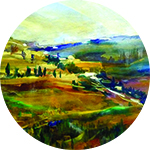Missing You


Do we realize what’s missing?
A s I near the end of aveilus for my father Rav Shimon Zev ben Yeshayahu z”l the thought of reentering the world of parties and dancing frightens me. I don’t want to forget the father whom I loved; I don’t want to lose that feeling that I’m missing something.
Does leaving the year of aveilus behind mean that I’ll be leaving the memories of my father behind as well?
And what does this mean for the period of aveilus that’s now upon us?
Summertime’s here with its long days of fun. But within our vacation come three weeks of mourning that encroach upon our grand plans.
This time period mocks our bronzed beach life echoing Shlomo Hamelech’s voice in Shir Hashirim (1:6): “Do not see me as if I am black for the sun has colored me.”
This forced mourning encourages us to take off those sunglasses and see who we really are behind the tan.
Seeing is Believing
There’s a famous mashal from the Dubno Maggid that illustrates our difficulty in mourning for the Beis Hamikdash.
After years of waiting a father was anxiously anticipating the moment when his precious child would be born. After hours of labor the doctor approached him with an inscrutable look. “Mazel tov upon the birth of your son; our condolences over the loss of your wife.”
Consequently every day in the life of this baby was linked to his departed mother — every birthday her yahrtzeit.
At the boy’s bar mitzvah the father turned to his son and said “The time has finally come that you can pay respect to your mother and recite Kaddish for the aliyah of her neshamah.”
Within a few seconds the boy finished Kaddish and asked “Now can we go home?”
Enraged the father responded “Aren’t you ashamed? Your mother gave up her life for you and you can’t even recite a meaningful Kaddish in her memory?”
“But I never knew my mother ” the boy defended himself. “To me she’s but a piece of history.”
Each one of us represents this son — we never knew the Beis Hamikdash so we struggle to mourn its loss.
Sticks and Stones
The Beis Hamikdash was the conduit that nourished the bond between us and our Creator. It was defiled by pitiless gentiles who placed an idol in our most holy place. What a crushing blow for our nation.
Yet Dovid Hamelech writes about the Churban (Tehillim 79:1): “A song for Assaf… gentiles came… and profaned Your Heichal….”
The Midrash asks (Eichah Rabbah 4): Why is this a song? Shouldn’t it say “A lamentation”? Rashi responds “Yes! A song! Because Hashem spent His anger by casting it on the sticks and stones and spared His children.”
But there was a heavy price to pay. While we were spared in destroying His Mikdash to preserve His people Hashem willingly distanced Himself from them.
The Gemara (Chagigah 5b) tells us that since that moment Hashem dwells in the mistarim and cries. As Yirmiyahu says (13:7): “In the mistarim — the hidden places — My Soul cries [says Hashem].”
While we’re so quick to forget the connection to our Father He never ceases yearning to connect. One time of year He begs His children “Remember Me — say Kaddish for Me!”
Yet we’re similar to that orphan — we never really knew this Father. So we look for ways to avoid mourning and avoid our discomfort. How many siyumim can we make during the Nine Days and eat meat? What’s the most comfortable way to sit on the floor?
Rav Moshe Yosef Sheinerman in his sefer Ohel Moshe calls this concept: “The severity of the distraction from mourning.” The Kuzari writes that it’s precisely this failure to feel our loss that prevents our Geulah.
Timeless Tears
This ugly reality already reared its head a mere 48 years after the Churban.
In 538 BCE Koresh the ruler of the Persian Empire allowed the Jews to return to Eretz Yisrael and rebuild the Beis Hamikdash. Yet only a paltry representation of the nation joined Ezra in his return to Tzion.
The Geulah could’ve been around the corner but the people were already so comfortably ensconced in galus that they failed to want the Beis Hamikdash.
Rav Nachman Leibowitz in the kuntress B’shvilei Hamoed explains that this tragedy has its roots in sentiments expressed centuries before. When the Spies returned from Eretz Yisrael it was the 9th of Av. The pasuk says (Bamidbar (14:1): “…and the nation cried on that night.” The Gemara (Taanis 29) says that from that one night of crying in vain Klal Yisrael would cry forever.
“They detested the most precious land!” (Tehillim 106:24). The Ramban cites this reason as the cause of the entire long history of our exile. The Spies may have had valid concerns and fears that caused them to cry. However says Rav Leibowitz does one fear something he loves? The intensity of love should have dispelled all trepidation.
When a person comes to the Heavenly Gates after 120 years he’ll be asked “Did you await Mashiach and the rebuilding of the Beis Hamikdash?”
Did we? Did each individual among us yearn for the time that we’d be reunited with our Father in this world? Why not?
Shlomo Hamelech states in Shir Hashirim (5:2): “I am asleep but my heart is awake.” It’s an echo in our subconscious that must reverberate from our hearts to our minds. What blocks this yearning is that we don’t appreciate our loss. Rav Yaakov Weinberg in his sefer Fundamentals and Faith explains that once one appreciates that the meaning of life is determined by closeness to his Creator then the loss of His Presence causes incredible pain. To avoid this we anaesthetize ourselves by distractions of self-delusionary pleasure. In doing so we dull our senses to the ultimate pleasure that a relationship with Hashem would offer.
Tangible and Tantalizing
Is all lost? Can we not teach ourselves to realize what’s missing? Rav Aharon Kotler (Mishnas Rabi Aharon 3:47) counsels us to study and think about what we’re lacking.
To actualize this I compare my own situation to that of Klal Yisrael. I knew my father intimately; I felt his loss. But now that aveilus is ending will his memory be lost as well?
No because I will always represent my father as his daughter. The new people I meet the new generations that’ll be born won’t know my father but they can connect to him through me. I’ll talk about him and I can show pictures. I have recordings of things he said and letters he wrote that I’ll always treasure. As a teacher of Torah I can perpetuate his lessons and legacy to others thus keeping his neshamah alive in this world.
So too we can teach ourselves to recognize what we lost. We can delve into the tefillos of Yom Kippur and imagine what it meant to see the Kohein Gadol emerge from the Holy of Holies his face shining with the certainty that all our sins were pardoned. When we touch the stones of the Kosel Hamaaravi aren’t we touching the corpse of our Mikdash? When we recite Mussaf isn’t this a snapshot of what once was?
Every time we daven Shemoneh Esreh we recount the benefits of a rebuilt Yerushalayim — freedom from exile ingathering of all Jews justice in our courts inequity and evil destroyed the Shechinah returned to Yerushalayim and the Kingdom of David on its throne.
Both the Written and Oral Torah are replete with examples that can awaken anticipation for the Beis Hamikdash when we study them with passion. Technology today has enabled us to physically see realistic models and virtually walk in the Beis Hamikdash and touch its holy vessels.
Rav Weinberg cites the Chumash Heichal HaBrachah Bereishis: “At all times your heart should be pining for and yearning for Hashem’s salvation.” And in doing so we’ll be allowing a new reality to actualize: an eternal Beis Hamikdash and the ultimate closeness to our Creator.
Let’s take off our sunglasses and truly see what we’re still missing.
Originally featured in Family First Issue 550. Rebbetzin Aviva Feiner is the rebbetzin of Congregation Kneseth Israel (The White Shul) and menaheles of Machon Basya Rachel Seminary both in Far Rockaway New York. If you have any comments or questions on this column please contact fundamentals@mishpacha.com
Oops! We could not locate your form.






